Abstract
The Joint European Torus (JET) is playing an important role in preparing for the operation of the future world’s largest tokomak, ITER. In this respect, the tritium campaign (C40) and second deuterium–tritium experiment (DTE2, C41) took place in the JET during the years 2021 and 2022. In this work, a corresponding irradiation scenario was utilized for the activation calculations of eight material foils located at the JET outer long-term irradiation station (OLTIS). Neutron-induced activities and dose rates at a 30 cm distance after shutdown at specified cooling intervals were calculated with the FISPACT-II code, employing the EAF-2010 nuclear and TENDL-2021 data libraries. The Monte Carlo MCNP6.2 particle transport code equipped with the FENDL-3.1d nuclear data library was used for the calculation of the neutron flux densities.
1. Introduction
The Joint European Torus (often referred to as just the JET) is the biggest tokamak experimental device ever operated, and it is one of only two devices to employ a deuterium/tritium mixture as fuel, the other being TFTR, which was discontinued in the late 1990s. The JET’s operations began in 1983, with the initial tritium experiment conducted in 1991 (the first time tritium was used in a tokamak for a fusion reaction), followed by DTE1 in 1997, and the trace tritium experiment in 2003. At the moment, the JET is in its decommissioning stage after the successful completion of DTE2 and DTE3, which included a long period of deuterium and tritium operations carried out between 2018 and 2023. The experimental campaigns conducted will significantly contribute to the development of the ITER project. The JET will provide crucial experimental data for formulating ITER’s operational strategies and advancing early designs for its optimal performance. The focus of the JET’s DT operation and the use of its data will be dedicated to supporting efforts toward achieving ITER’s research goal [,].
The following paragraph provides a summary of the JET’s experiment global technical parameters. The most crucial technical data are composed of numerous fundamental components. The first wall is made of solid tungsten (the divertor), tungsten-coated carbon fiber composites (CFCs) (also in the divertor’s construction), and Be (the main chamber). The JET employs 16 toroidal field coils and 12 poloidal field coils, producing a maximum magnetic field of 3.45 T (normal) and 3.9 T (exceptional). The plasma current ranges from 1.0 MA to 4.0 MA, with pulse durations of <10–40 s, depending on TF, heating, and other factors. The JET can achieve plasma heating of up to ~40 MW with neutral beam injections of 32 MW of deuterium, 36 MW of tritium, and 14 MW of helium, with pulse times as short as ~30 min. The injection energy can reach 125 kV, and the ion cyclotron heating can be as much as 5 MW at 25–55 MHz [,].
JET tests using a deuterium and tritium (D-T) fuel combination, which is intended for fusion power plants, offer a rare chance to verify current D-T fusion power prediction techniques in support of developing future fusion reactor machines and operation preparedness. To improve the D-T operating scenarios and develop future D-T fusion reactors, reliable predictions of deuterium and tritium (D-T) neutronics and radiological characteristics are essential. The second JET D-T experimental campaign was conducted by EUROfusion in 2021 using optimized operating scenarios. Under ITER-relevant conditions, i.e., operation with a baseline or hybrid scenario in the complete metallic wall, D-T fusion power sustained for over 5 s was attained [,].
Many assumptions based on D discharges were used in D-T prediction modeling, which was carried out in advance of the 2021 JET D-T experimental program. It is crucial to indicate the accuracy of D-T neutron predictions, together with the experiments, and to apply the simulation input data from the 2021 JET D-T discharges to current radiological characteristic modeling in order to increase the validity of ITER D-T predictive modeling in the future [,].
It is crucial to analyze in detail the models and simulation settings used in inventory modeling to indicate additional improvements needed in current nuclide pathway estimation tools and to indicate the accuracy of D-T fusion neutronic predictions with respect to measured values in 2021 JET D-T discharges in order to increase the validity of deuterium–tritium neutron source modeling.
The neutron energy from D-T fusion reactions scales higher than it does for DD reactions. Therefore, this calls for complex integrated modeling that accurately forecasts radiological properties through the simulation of neutron transport, decay heat, activation, and dose rate. Thus, it is essential to quantitatively evaluate current neutronics and inventory modeling tools using available experimental data in order to ensure reliable nuclide generation prediction and to identify the areas in which simulation tools need to be used in order to ensure safe operational conditions for fusion reactor operators. Having this in mind, nuclear waste management is very sensitive to materials’ radiological characteristics, making it a difficult process to predict. The JET D-T experimental campaign offered a unique opportunity to validate current D-T fusion power materials’ activation predictions prior to the ITER D-T experiments since no additional D-T experimental campaigns are anticipated in 2024 in any other ITER partner’s current facilities before the ITER operation and experiment campaigns using the deuterium–tritium neutron source [,].
The main objective of this work was to perform a detailed calculation of activities and dose rates for metal foils located at the JET outer long-term irradiation station (OLTIS) [,,]. Irradiation simulations are based on the actual tritium (C40) [,] and DTE2 (C41) [,,] campaigns. Neutron-induced activation after the shutdown was calculated with FISPACT-II activation and the transmutation inventory code [] by employing the EAF-2010 [] and TENDL-2021 [] nuclear data libraries.
2. Methods and Materials
FISPACT-II is a nuclide inventory code that models radiation damage, time-dependent inventory, and activation–transmutation processes using nuclear data library databases. The Culham Center of Fusion Energy (CCFE) is where the FISPACT code was conceived and created. The code algorithm was created for computations of material activation produced by neutrons, deuterons, and protons in nuclear devices.
The FISPACT-2 code computational framework encompasses a few key stages aimed at resolving a given problem. Firstly, nuclear data libraries serve as the primary sources of information. In this study, computations were performed employing the EAF-2010 and TENDL-2021 nuclear data libraries. EAF-2010 is an original FISPACT data library based on the JEF-1 [] and JEFF3.1.1 [] nuclear libraries. TENDL-2021 is a third-party universal nuclear library encompassing reaction energy data caused by various particles, including neutrons, protons, photons, alpha particles, and others, up to an energy of 200 MeV. The TENDL nuclear data libraries are regarded as some of the most comprehensive available and are routinely updated every few years. Both nuclear databases use evaluated experimental data to describe the reaction cross-sections (the data are weighted by the relevance and reliability of the experiments performed). Outside of the novelty of experimental data, the main difference between EAF-2010 and TENDL-2021 is that the latter, besides the experimental data, also uses mathematical modeling to account for the missing isotopes and energy ranges [].
After the selection of libraries, a number of input files are prepared that describe the irradiation scenario and material composition. An irradiation scenario is divided into irradiation history and particle spectra. Our original neutron spectra obtained with neutron transport calculations correspond to a 175-energy-group structure [], which is a standard for EAF-2010 deuterium–tritium nuclear fusion applications. The FISPACT-II code converts this spectrum into its own standard of 709 energy groups [], interpolating values in between. TENDL-2021, on the other hand, only uses 1102 energy groups, so another conversion is required.
After the input deck is set, deterministic methods are employed to obtain activation results through the solution of a set of differential rate equations. By solving Bateman differential equations, the yield of various radionuclides in materials following irradiation and cooling steps is derived. In FISPACT-II calculations, a slab of homogeneous material extending infinitely and diluted to an infinite degree is exposed to a time-varying flux of neutron projectiles, corresponding to the operational sequences of a fusion device [].
Finally, radiological quantities are computed and generated. Additionally, the code provides information about uncertainty, and a pathway analysis of nuclear reactions is carried out. Presently, the FISPACT code is widely adopted by multiple research teams across Europe, playing a pivotal role in computing neutron activation products in the JET experimental fusion reactor.
In our case, we used an elaborate irradiation scenario representing two JET campaigns consisting of three parts: a tritium experiment (C40) and Deuterium–Tritium Experiment 2 (C41). We have used daily DD (2.45 MeV) and DT (14 MeV) neutron budgets from irradiation sessions. As for tritium–tritium (TT) reactions, a neutron conservative assumption was applied: that the neutron yield for this reaction is two times larger than for DD neutrons. Tritium can be injected into the plasma mixture, or it can be created from DD reactions. There is also a possibility of having traces of tritium in a system from previous operations. The neutron budgets for DD and DT reactions are seen in Figure 1 and Figure 2. Also note that the tritium campaign was split into two parts and was conducted before and after the DTE2 experiment. Every experiment in the C40 and C41 campaigns serves multiple purposes, focusing on issues such as plasma confinement modes, radiometric and neutronic measurements, and the testing of operational and auxiliary systems and procedures.
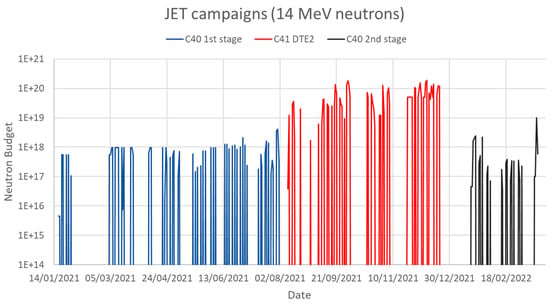
Figure 1.
The 14 MeV neutron (D-T reaction) budget for irradiation campaigns.
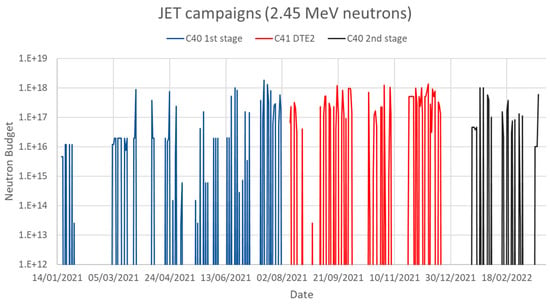
Figure 2.
The 2.45 MeV neutron (D-D reaction) budget for irradiation campaigns.
The entire scenario consists of 425 days, of which 151 days are dedicated to irradiation. As for the second stage of the tritium experiment, some other experiment sessions referred to as M18 and M21 are also included in this campaign in our calculation due to their being mixed into the C40 campaign and presenting significant budgets for DD and DT neutrons.
In general, the DTE2 (C41) daily neutron total budgets are much higher on average (almost by two orders of magnitude) compared to those of the C40 campaigns. However, the difference is smaller if you consider the cumulative neutron budgets.
The subject of investigation were eight metallic foils of different elemental compositions located at the JET outer long-term irradiation station (OLTIS):
- -
- Silver;
- -
- Gold;
- -
- Manganese (88%) and nickel (12%);
- -
- Niobium;
- -
- Nickel;
- -
- Rhodium;
- -
- Titanium;
- -
- Yttrium.
The compositions of the foils are selected in accordance with their potential use as part of activation detectors [].
The specific activities and dose rates for the metallic foils were calculated in accordance with the JET C40 and DTE2 campaigns. Foils located at the JET OLTIS are affected by neutrons created from deuterium–deuterium, deuterium–tritium, and tritium–tritium fusion reactions. The neutron flux densities were calculated with the Monte Carlo N-Particle transport code (MCNP6.2) [] with an already validated JET MCNP model [] (the MCNP geometry is presented in Figure 3) together with the FENDL-3.1d [] nuclear data library.

Figure 3.
MCNP geometry model of the JET and the location of the OLTIS.
Neutron spectra (Figure 4 and Figure 5) were adapted for the C40 and DTE2 campaigns. In total, 151 unique spectra were created for each irradiation day by varying the DD, TT, and DT neutron budgets.
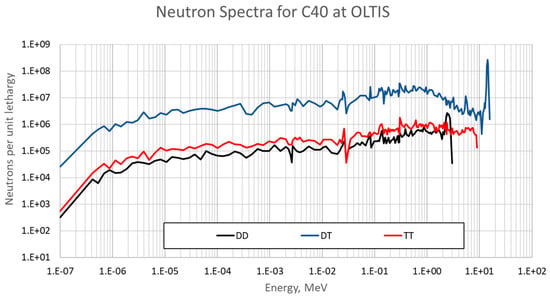
Figure 4.
Neutron spectra for DD, DT, and TT reactions for the OLTIS sample irradiation location during the C40 campaign (day 54).
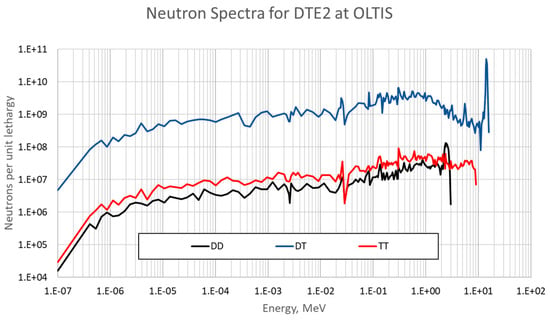
Figure 5.
Neutron spectra for DD, DT, and TT reactions for the OLTIS sample irradiation location during the DTE2 campaign (day 257).
The irradiation scenario considered for the activation calculations was based on the current JET operation schedule. For simplification, the assumption was made that the device operated continuously on the day of operation. The operation schedule is provided on a day-to-day basis. In reality, the irradiation pulses are very short and often scattered across the day for a specific experimentation task at the JET.
- (1)
- C40 Campaign, part 1:
The C40 campaign (also known as a tritium experiment) is expected to have 2.92 × 1018, 5.84 × 1019, and 1.28 × 1019 neutron yields for DD, TT, and DT fusion reactions, respectively. Although it is a pure tritium experiment, due to the possible residual presence of deuterium in the vacuum vessel (with a conservative estimate of 1%), the majority of fusion reactions will still be DT reactions. Before the start of the tritium campaigns, efforts to minimize the presence of deuterium are expected.
- (2)
- DTE2 Campaign:
The DTE2 campaign (also known as a deuterium–tritium experiment) is expected to have 6.10 × 1018, 1.22 × 1019, and 9.29 × 1020 neutron yields for DD, TT, and DT fusion reactions, respectively. DTE2 should provide the highest fusion neutron yield so far of all magnetic confinement fusion devices in experimental settings.
- (3)
- C40 Campaign, part 2:
The second part of the C40 campaign is expected to have 5.08 × 1018, 1.16 × 1019, and 2.26 × 1019 neutron yields for DD, TT, and DT fusion reactions, respectively. In the calculation, this campaign also includes other experiments that were conducted with deuterium and tritium within the timeframe of the C40 campaign but are not covered by the C40 denomination.
3. Results
The neutron-induced specific activities and dose rates at 30 cm from the point source of 1 g of material after shutdown were calculated at the following cooling intervals: 1 s, 1 min, 1 h, 1 day, 1 week, 1 month, 1 year, and 2 years. Later on, a short analysis of the irradiation sequence is also presented, focusing on the DTE2 campaign.
The majority of activation reactions were basic neutron capture processes with corresponding photon emissions. Subsequent analyses are presented for the results obtained with the EAF-2010 nuclear data library; however, some cases include extra information on the TENDL-2021 results.
3.1. Silver
The silver (Figure 6) foil exhibits the third highest initial activity and the highest activity after 2 years of cooling, with values exceeding the 12 MBq/kg limit in all the examined scenarios. Natural silver is made of Ag107 (~52%) and Ag109 (~48%) isotopes. The most significant contributors to total activity and dose rates at the end of irradiation are Ag110 from Ag109(n,g), Ag108 from Ag107(n,g), and Ag110m from Ag109(n,g). Ag110m retains a relatively level of high activity and photon emissivity for the whole 2-year cooling period.
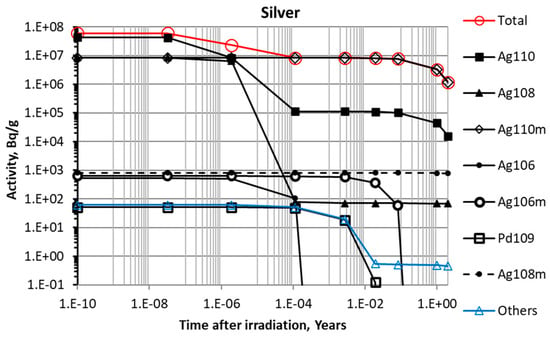
Figure 6.
Specific activities in silver after full irradiation.
3.2. Gold
Gold (Figure 7) has the second highest activity and the second highest dose rate after the end of irradiation. It retains a high level of activity for around one week. Au198 (half-life ~2.7 days) produced from an Au197(n,g) reaction is, by a large margin, the most important radionuclide in gold activation. Gold activation is also contributed to by metastable isotopes with different excitation energies. Gold is also the material that loses the largest amount of activity after 2 years of cooling.
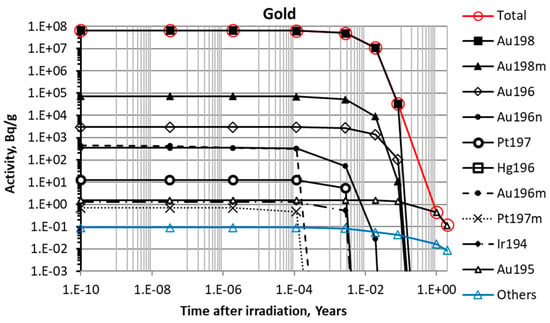
Figure 7.
Specific activities in gold after full irradiation.
3.3. Manganese/Nickel
The manganese/nickel foil (Figure 8), with, respectively, 88% and 12% weight fractions, has the fourth highest activity and the highest dose rate among the investigated materials at the end of irradiation. Its activity and dose rate significantly decrease in the first hour of cooling. Mn56 (half-life ~2.5 h) is the dominant radionuclide produced from Mn55(n,g) reactions. Mn54 (half-life ~312 days) from Mn55(n,2n) reactions is responsible for the majority of activity and dose rates after 2 years of cooling. Ni63 is a radioisotope that is known for its relatively long half-life, contributing to its activity beyond the investigated interval.
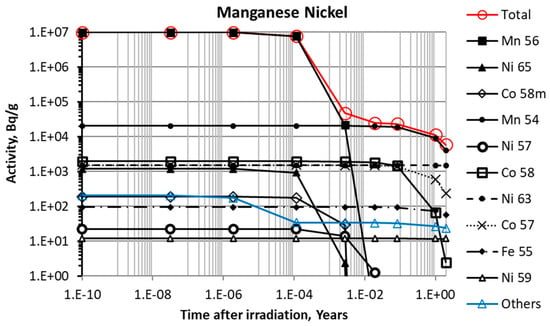
Figure 8.
Specific activities in manganese/nickel foil after full irradiation.
3.4. Niobium
The activity of niobium (Figure 9) within the first few minutes of cooling is mostly contributed to by Nb94m produced from a Nb93(n,g) reaction. Nb92m produced from Nb93(n,2n) is responsible for the majority of activity within the first month of cooling. As for the dose rate, the gap between Nb94m and Nb92m is much more pronounced, as in the case of activity. Despite having comparable activity to gold, manganese, and silver, its dose rate is lower by a factor of an order of magnitude or more. Compared to the TEND2021 results, the EAF-2010 activity just after irradiation is almost two times higher; however, the main radioisotopes are the same. This means that the TENDL-2021 reaction cross-sections are simply smaller compared to those of EAF-2010 for the analyzed neutron spectra. This difference in activity persists after two years; however, it is now inversed, and TENDL-2021 exhibits a higher level of activity, mainly due to Nb 93m, which is irrelevant in the EAF-2010 case.
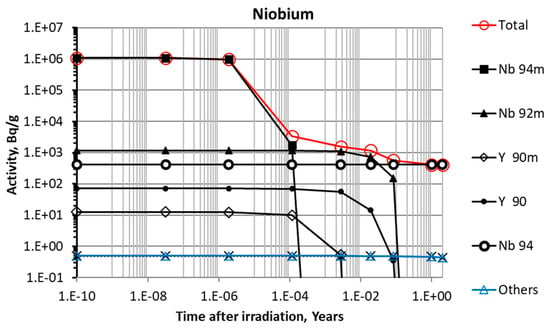
Figure 9.
Specific activities in niobium after full irradiation.
3.5. Nickel
Nickel (Figure 10) has a relatively low level of activity and dose rate. The main contributors are Ni57 from Ni58(n,2n), Co60m from Ni60(n,p), and Co58 from Ni58(n,p) (~55%) and from the isomeric transition of Co58m (~45%). Nickel also has a few long-lasting isotopes, namely Co60 (half-life ~5.27 years) and Ni63 (half-life ~100.1 years).
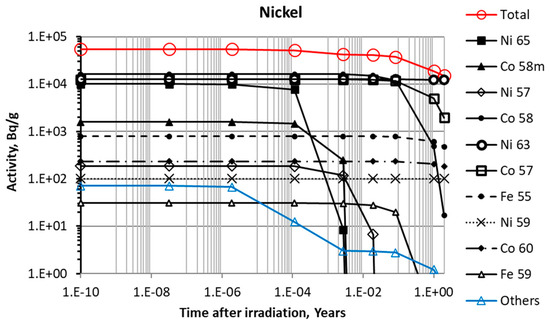
Figure 10.
Specific activities in nickel after full irradiation.
3.6. Rhodium
The rhodium (Figure 11) foil has the highest activity among the investigated materials. Rh104 (half-life 42.3 s) is mainly produced from Rh103(n,g) and is the most important radionuclide within the first few minutes of cooling, followed by Rh104m from the same reaction. Rh104m also turns into Rh104 after an isomeric transition. Rh102 and Rh102m are produced from Rh103(n,2n) and are mainly responsible for the activities and dose rate in later cooling periods. Despite its notable activity, the dose rates of rhodium do not stand out from the others.
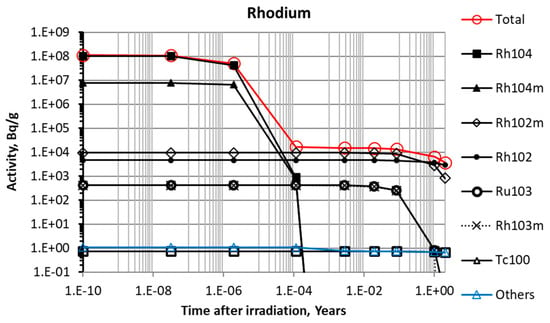
Figure 11.
Specific activities in rhodium after full irradiation.
3.7. Titanium
Titanium (Figure 12) has the lowest level of activity and the second lowest dose rate among the examined foils after the end of irradiation. Three nuclides stand out: Ti 51 produced from Ti50(n,g), Sc48 produced from a Ti48(n,p) reaction for activity, and Sc46 mainly produced from Ti46(n,p) for activity and dose rate. Sc46 is produced from Ti46, which constitutes around 8% of its natural abundance.
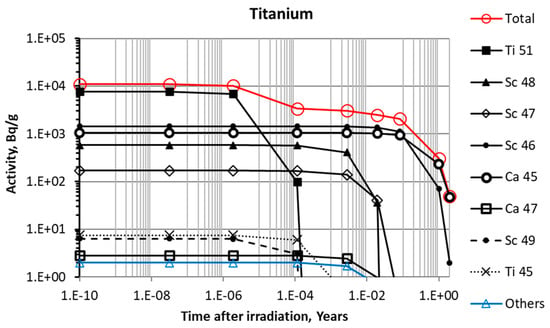
Figure 12.
Specific activities in titanium after full irradiation.
3.8. Yttrium
Yttrium (Figure 13) has a relatively low level of activity and a high dose rate compared to the other foils. Y90 produced from an Y89(n,g) reaction is responsible for most of the activity within the first week of cooling, later surpassed by Y88 from Y89(n,2n). As for the dose rate, Y88 dominates over the whole cooling interval.

Figure 13.
Specific activities in yttrium after full irradiation.
3.9. Irradiation Sequence Analysis and General Overview of Nuclear Data Comparison
In this section, the results from the irradiation sequence are presented. As can be seen from the neutron budgets in the previous graphs, the DTE2 reaction has the highest level of activity (Figure 14) and dose rates. Like in the after-irradiation analysis, rhodium exhibits the highest level of activity during irradiation, peaking at over 10 × 1010 Bq/g a couple of times, followed by less-active silver and gold. Interestingly enough, despite the rapid decay, gold remains quite active throughout the entire campaign.
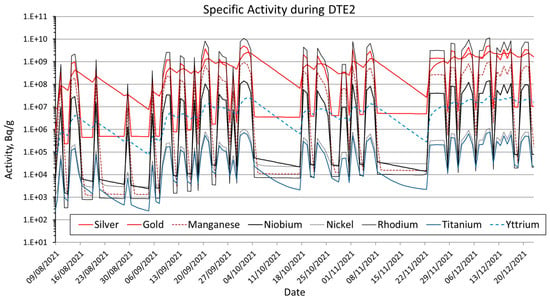
Figure 14.
Evolution of specific activities during the DTE2 campaign.
As stated in the previous niobium analysis section, it has the biggest discrepancy between the nuclear databases utilized. It is evident (Figure 15) that on every irradiation day, the EAF-2010 data library produced higher levels of activation. Surprisingly, the inversion of the activity trend is only seen at the very end of the last tritium campaign. FISPACT-2 gives a very different interpretation of Nb93m generation for the different data libraries. In the case of the EAF-2010 nuclear data library, radionuclide is produced mostly by Zr93 beta decay, while in TENDL-2021, its production is grounded in neutron excitation (n,n) reactions.
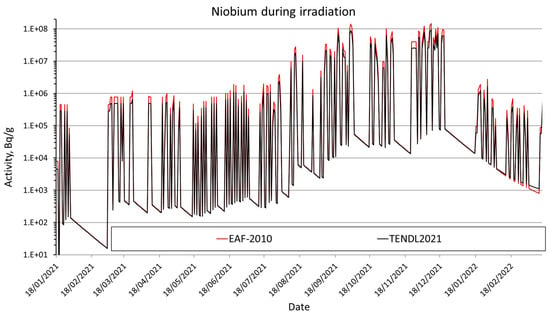
Figure 15.
Specific activity of niobium during irradiation. Comparison between the EAF-2010 and TENDL-2021 nuclear data libraries.
In the following tables (Table 1 and Table 2), the numerical values of the results are presented for the activities and dose rates for different nuclear data libraries. Outside of niobium, some other cases also have significant differences in the obtained values. Gold’s activity decrease is less in EAF-2010 compared to TENDL-2021 due to larger Au195 production, which is the most relevant isotope for a 1-year cooling period. There is also a noticeable difference in gold’s dose rates. Initially, different estimations of Au198 cause these differences, but at longer cooling intervals, Au195 is the responsible isotope. While some uncertainties are present in the nuclear data, such as the cross-sections themselves, there are also uncertainties stemming from the selection of energy groups. Uncertainties also tend to increase with the increase in cooling times as more rare radionuclides show up, originating from the difficult decay schemes.

Table 1.
Specific activities of metallic foils. Comparison between the EAF-2010 and TENDL-2021 nuclear data libraries.

Table 2.
Dose rates at 30 cm distance from 1 g of material. Comparison between the EAF-2010 and TENDL-2021 nuclear data libraries.
Overall, the gold foil has the highest dose rate after the end of irradiation out of the investigated materials. The dose rates for all the foils fall into a range between 50 nSv and 1 pSv per hour after the end of irradiation. Therefore, it should not pose a high radiation exposure risk if care is taken.
4. Conclusions
The objective of this work was to numerically investigate the activation of eight metal foils placed at the JET outer long-term irradiation station during the C40 (Tritium) and C41 (Deuterium Tritium Experiment 2) campaigns. This was achieved by constructing a complex irradiation scenario based on the daily DT and DD neutron yields used in the experiment installation sessions. Numerical estimations of the induced activities after the end of irradiation are important for the optimization of the methodology for handling activated components, such as the activation foils. The FISPACT-II code and the EAF-2010 and TENDL-2021 nuclear data libraries were used for the calculations. In the comparison results, some significant discrepancies were observed between the niobium and gold results. The initial niobium activity, primarily from Nb94m resulting from the Nb93(n,g) reaction, peaks within minutes of cooling. Within the first month, Nb92m, produced from Nb93(n,2n), becomes the dominant contributor. Despite its comparable activity to gold, manganese, and silver, niobium’s dose rate is significantly lower. TENDL-2021 exhibits lower activity compared to EAF-2010, with these differences attributed to its smaller reaction cross-sections. Surprisingly, the cross-sections for the peak 14 MeV energy are higher for TENDL-2021 compared to EAF-2010 and are more true to the experimental data obtained by Rigaud et al. []; however, TENDL-2021 has a dip in cross-section values in the range 2 MeV–10 MeV compared to EAF-2021, as it follows the experimental data by Poenitz [] for up to 2.5 MeV. There are also discrepancies in the fast neutron and thermal neutron resonance ranges. After two years, TENDL-2021 shows increased activity, primarily due to Nb93m, which is negligible in EAF-2010. Gold exhibits the second highest activity and dose rate post-irradiation, with its peak activity sustained for approximately one week. Au198, stemming from the Au197(n,g) reaction and with a half-life of around 2.7 days, dominates gold activation. Metastable isotopes with varying excitation energies also contribute to this. Notably, gold experiences the most significant decline in activity after two years of cooling. In EAF-2010, gold’s activity decreases less than in TENDL-2021, primarily due to an increased production of Au195, which is the most relevant isotope during the first year of cooling. The dose rates for gold also differ noticeably. Initially, variations in the estimation of Au198 contribute to these differences, but over longer cooling periods, Au195 emerges as the responsible isotope.
The key findings are as follows:
- The highest levels of activity after the end of irradiation were observed in the rhodium foil, followed by the gold and silver foils.
- The highest levels of activity after two years of cooling were present in the silver foil, followed by the nickel and manganese and nickel alloy foils.
- The highest dose rates after the end of irradiation were observed in the gold foil, followed by the silver and nickel manganese foils.
- The highest dose rates after two years of cooling were observed in the silver foil, followed by the manganese nickel and rhodium foils.
Author Contributions
Conceptualization, A.T.; Formal analysis, A.T. and S.B.; Investigation, S.B.; Writing—original draft, A.T.; Writing—review & editing, G.S.; Supervision, G.S. All authors have read and agreed to the published version of the manuscript.
Funding
This work was carried out within the framework of the EUROfusion Consortium, funded by the European Union via the Euratom Research and Training Programme (Grant Agreement No. 101052200—EUROfusion). The views and opinions expressed are, however, those of the author(s) only and do not necessarily reflect those of the European Union or the European Commission. Neither the European Union nor the European Commission can be held responsible for them.
Data Availability Statement
The raw data supporting the conclusions of this article will be made available by the authors on request.
Acknowledgments
JET Contributors: See the author list of “Overview of JET results for optimising ITER operation” by J. Mailloux et al. published in the Nuclear Fusion Special Issue: Overview and Summary Papers from the 28th Fusion Energy Conference (Nice, France, 10–15 May 2021).
Conflicts of Interest
The authors declare no conflict of interest.
References
- Loughlin, M.; Forrest, R.; Edwards, J. Neutron activation studies on JET. Fusion Eng. Des. 2001, 58–59, 967–971. [Google Scholar] [CrossRef]
- Joffrin, E.; Abduallev, S.; Abhangi, M.; Abreu, P.; Afanasev, V.; Afzal, M.; Aggarwal, K.M.; Ahlgren, T.; Aho-Mantila, L.; Aiba, N.; et al. Overview of the JET preparation for deuterium–tritium operation with the ITER like-wall. Nucl. Fusion 2019, 59, 112021. [Google Scholar] [CrossRef]
- Mailloux, J.; Abid, N.; Abraham, K.; Abreu, P.; Adabonyan, O.; Adrich, P.; Afanasev, V.; Afzal, M.; Ahlgren, T.; Aho-Mantila, L.; et al. Overview of JET results for optimising ITER operation. Nucl. Fusion 2022, 62, 042026. [Google Scholar] [CrossRef]
- Lengar, I.; Žohar, A.; Batistoni, P.; Popovichev, S.; Conroy, S.; JET Contributors. Characterization of JET neutron field in irradiation locations for DD, DT and TT plasmas. Fusion Eng. Des. 2019, 146, 1967–1970. [Google Scholar] [CrossRef]
- Žohar, A.; Lengar, I.; Batistoni, P.; Conroy, S.; Čufar, A.; Kierepko, R.; Kos, B.; Loreti, S.; Mietelski, J.W.; Nobs, C.R.; et al. Long Term Neutron Activation in JET DD Operation. EPJ Web Conf. 2021, 253, 03005. [Google Scholar] [CrossRef]
- Packer, L.W.; Batistoni, P.; Bradnam, S.C.; Colling, B.; Conroy, S.; Ghani, Z.; Gilbert, M.R.; Jednorog, S.; Łaszyńska, E.; Leichtle, D.; et al. Activation of ITER materials in JET: Nuclear characterisation experiments for the long-term irradiation station. Nucl. Fusion 2018, 58, 096013. [Google Scholar] [CrossRef]
- Fonnesu, N.; Loreti, S.; Villari, R.; Raj, P.; Klix, A.; Batistoni, P.; Contributors, J. Dose Rate Measurements during the Tritium Campaign at JET and Diagnostic Improvements for the Deuterium–Tritium Experiments. IEEE Trans. Plasma Sci. 2022, 50, 4131–4137. [Google Scholar] [CrossRef]
- Groth, M.; Solokha, V.; Aleiferis, S.; Brezinsek, S.; Brix, M.; Carvalho, I.S.; Carvalho, P.; Corrigan, G.; Harting, D.; Horsten, N.; et al. Characterisation of divertor detachment onset in JET-ILW hydrogen, deuterium, tritium and deuterium–tritium low-confinement mode plasmas. Nucl. Mater. Energy 2023, 34, 101345. [Google Scholar] [CrossRef]
- Fonnesu, N.; Villari, R.; Loreti, S.; Angelone, M.; Pilotti, R.; Klix, A.; Batistoni, P. The preparation of the Shutdown Dose Rate experiment for the next JET Deuterium-Tritium campaign. Fusion Eng. Des. 2017, 123, 1039–1043. [Google Scholar] [CrossRef]
- Batistoni, P.; Campling, D.; Conroy, S.; Croft, D.; Giegerich, T.; Huddleston, T.; Lefebvre, X.; Lengar, I.; Lilley, S.; Peacock, A.; et al. Technological exploitation of Deuterium–Tritium operations at JET in support of ITER design, operation and safety. Fusion Eng. Des. 2016, 109–111, 278–285. [Google Scholar] [CrossRef]
- Fonnesu, N.; Villari, R.; Flammini, D.; Batistoni, P.; Fischer, U.; Pereslavtsev, P. Shutdown dose rate studies for the DTE2 campaign at JET. Fusion Eng. Des. 2020, 161, 112009. [Google Scholar] [CrossRef]
- Sublet, J.-C.; Eastwood, J.W.; Morgan, J.G. The FISPACT-II User Manual; Technol. Rep.; CCFE: Abingdon, UK, 2013. [Google Scholar]
- Sublet, J.-C. The European Activation File: EAF-2010 Neutron-Induced Cross Section Library; Euratom/CCFE Fusion Association: Abingdon, UK, 2010. [Google Scholar]
- Koning, A.J.; Rochman, D.; Sublet, J.-C.; Dzysiuk, N.; Fleming, M.; van der Marck, S. TENDL: Complete Nuclear Data Library for Innovative Nuclear Science and Technology. Nucl. Data Sheets 2019, 155, 1–55. [Google Scholar] [CrossRef]
- NEA. JEF-1 Nuclear Data Library, Volume I, General Purpose File; JEF Report 1; OECD Publishing: Paris, France, 1985. [Google Scholar]
- NEA. The JEFF-3.1.1 Nuclear Data Library; OECD Publishing: Paris, France, 2009. [Google Scholar]
- Sartori, E. Standard Energy Group Structures of Cross Section Libraries for Reactor Shielding, Reactor Cell and Fusion Neutronics Applications: VITAMIN-J, ECCO-33, ECCO-2000 and XMAS, OECD/NEA Data Bank. 1990. Available online: https://www.oecd-nea.org/tools/abstract/detail/nea-1344/ (accessed on 17 March 2024).
- Thomas, F.; Fleming, M. Optimised energy group structures for fusion activation calculations. Fusion Eng. Des. 2018, 136, 1479–1483. [Google Scholar] [CrossRef]
- Sublet, J.-C.; Eastwood, J.W.; Morgan, J.G.; Gilbert, M.R.; Fleming, M.; Arte, W. FISPACT-II: An Advanced Simulation System for Activation, Transmutation and Material Modelling. Nucl. Data Sheets 2017, 139, 77–137. [Google Scholar] [CrossRef]
- Stamatelatos, I.E.; Savva, M.I.; Vasilopoulou, T.; Triantou, K.; Mergia, K.; Messoloras, S.; Packer, L.W.; Nobs, C.R.; Ghani, Z.; Batistoni, P.; et al. Novel Neutron Activation Detector for Fusion; Modern Neutron Detection, IAEA TECDOC Series; International Atomic Energy Agency: Vienna, Austria, 2020; pp. 301–312. ISSN 1011–4289. [Google Scholar]
- Werner, C.J.; Bull, J.S.; Solomon, C.J.; Brown, F.B.; McKinney, G.W.; Rising, M.E.; Dixon, D.A.; Martz, R.L.; Hughes, H.G.; Cox, L.J.; et al. MCNP6.2 Release Notes; LA-UR-18-20808; Los Alamos National Laboratory (LANL): Los Alamos, NM, USA, 2018.
- Snoj, L.; Syme, B.; Popovichev, S.; Lengar, I.; Conroy, S. Calculations to support JET neutron yield calibration: Contributions to the external neutron monitor responses. Nuc. Eng. Des. 2012, 246, 191–197. [Google Scholar] [CrossRef]
- Sawan, M.E. Summary Report from the Third RCM on Nuclear Data Libraries for Advanced Systems—Fusion Devices (FENDL 3); INDC(NDS)-602; IAEA Nuclear Data Section: Vienna, Austria, 2011. [Google Scholar]
- Rigaud, F.; Irigaray, J.L.; Petit, G.Y.; Longo, G.; Saporetti, F. Gamma-ray spectra following the capture of 14 MeV neutrons by 59Co, 93Nb and 103Rh. Nucl. Phys. A 1971, 173, 551–560. [Google Scholar] [CrossRef]
- Poenitz, W.P. Fast Neutron Capture and Activation Cross Sections of Niobium Isotopes; ANL/NDM-8; Argonne National Laboratory: Lemont, IL, USA, 1974.
Disclaimer/Publisher’s Note: The statements, opinions and data contained in all publications are solely those of the individual author(s) and contributor(s) and not of MDPI and/or the editor(s). MDPI and/or the editor(s) disclaim responsibility for any injury to people or property resulting from any ideas, methods, instructions or products referred to in the content. |
© 2024 by the authors. Licensee MDPI, Basel, Switzerland. This article is an open access article distributed under the terms and conditions of the Creative Commons Attribution (CC BY) license (https://creativecommons.org/licenses/by/4.0/).